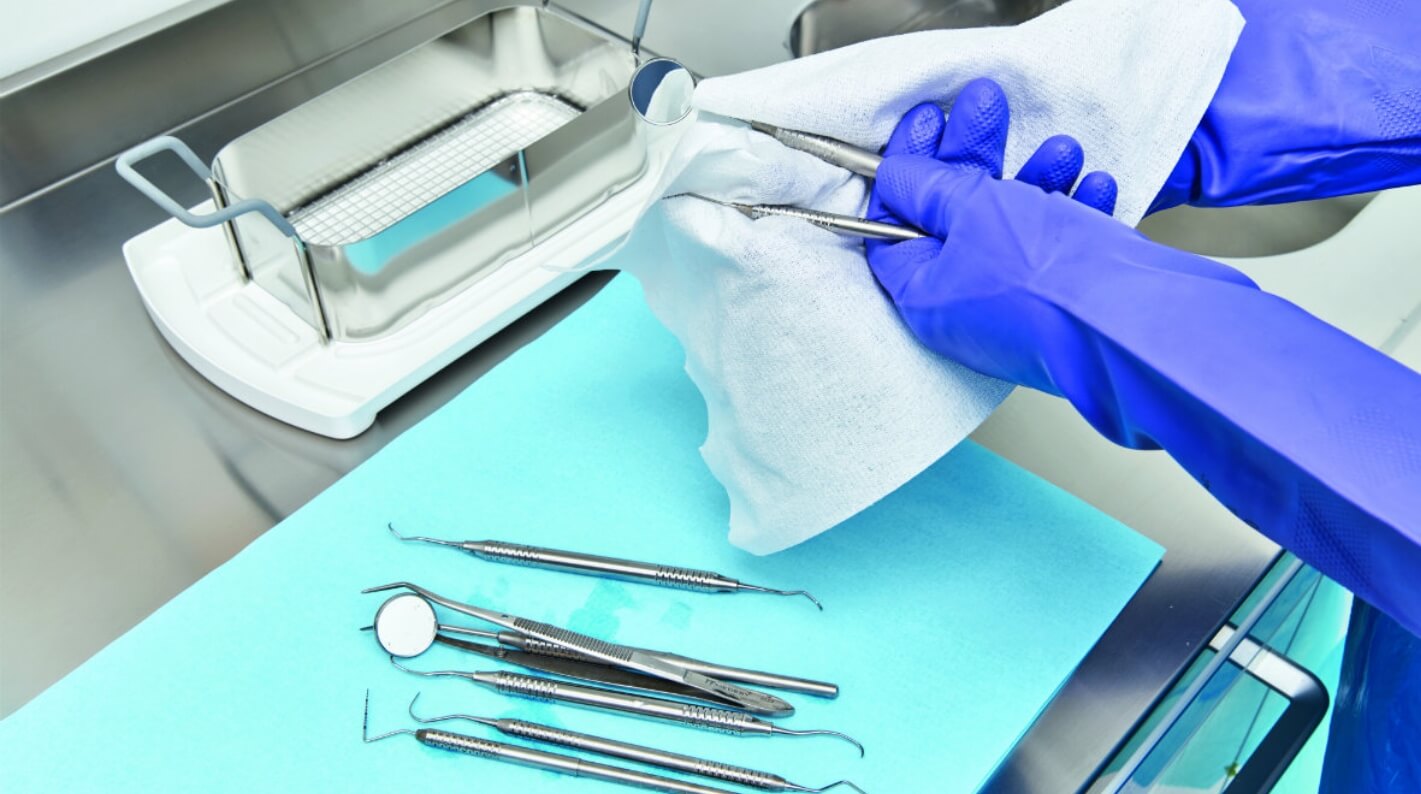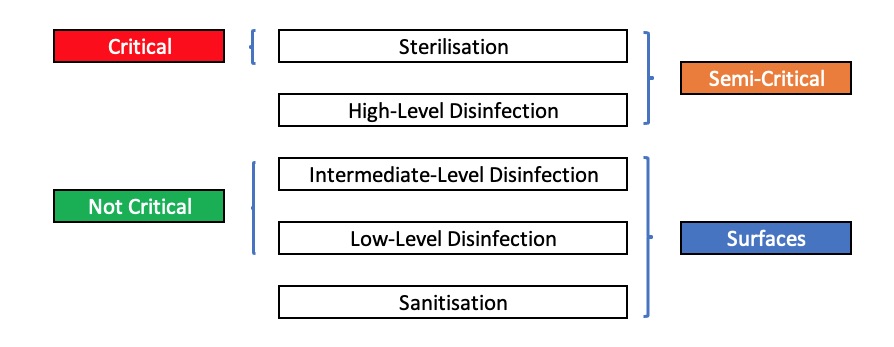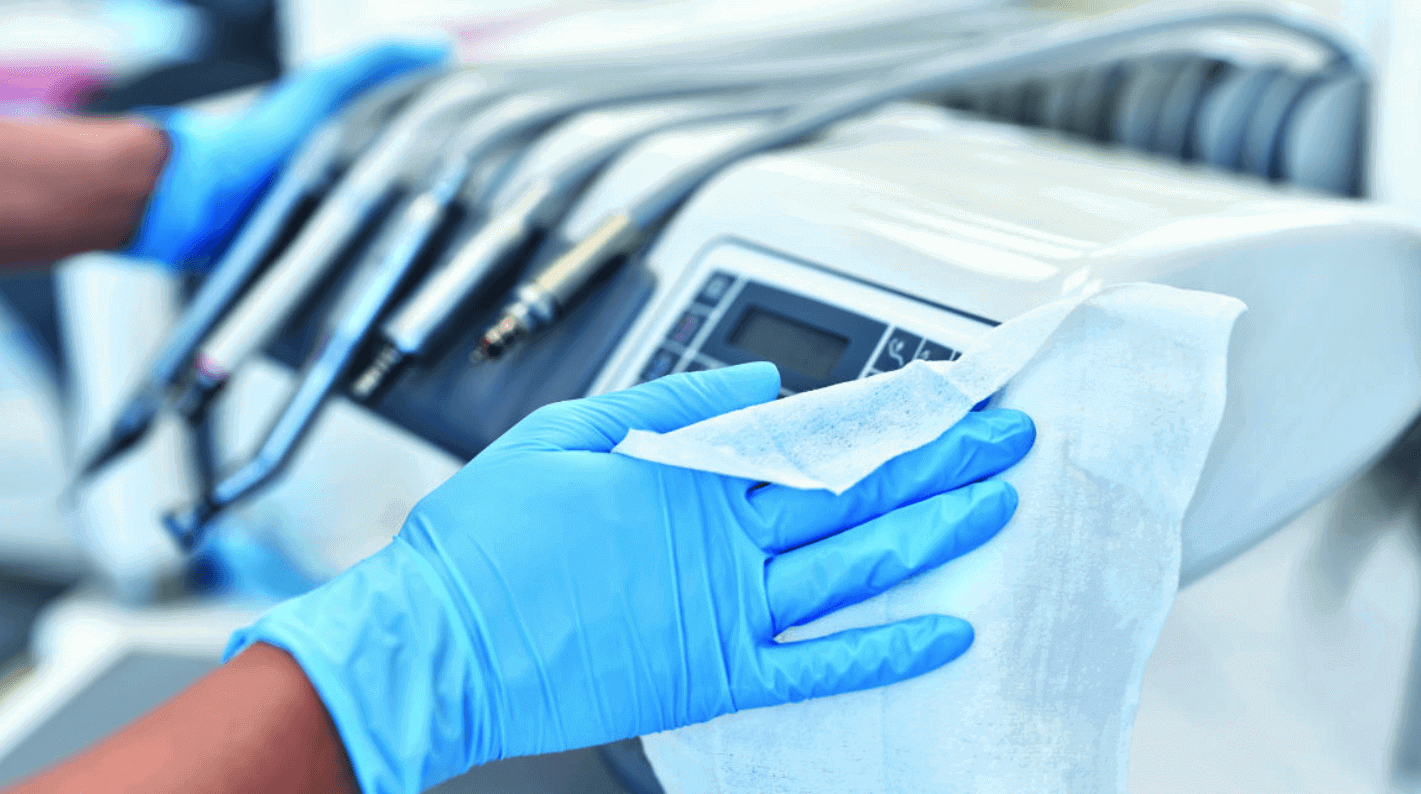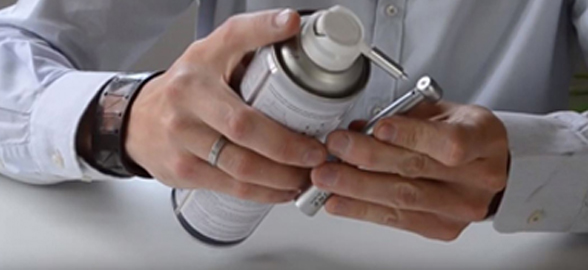Disinfection and sterilisation guarantee patient health and, as such, are fundamental processes in a dental clinic. They are designed to destroy all microscopic life forms, preventing the transmission of infections through reusable tools. The two concepts are sometimes confused, but they are not the same thing, so we're going to tell you how disinfection and sterilisation differ from one another and how they are carried out. Ready? Let's get started!

What is cleaning, disinfection and sterilisation and what are the differences between them?
Cleaning, which is done with soap and water, is simply the destruction of dirt and organic material. It eliminates a large proportion of microorganisms, but not all of them. The method that does achieve this is disinfection, thanks to chemical or physical procedures. However, disinfection processes do not remove fungal spores. This requires sterilisation, which prevents microorganisms from surviving, reproducing or causing infections.
Not all dental instruments carry the same risk of infection. Dr. E. H. Spaulding's classification makes this more clear:
- Critical. This group includes sharp surgical instruments or those that are inserted into tissues. For example, surgical, periodontal or endodontic instruments. They must always be sterilised after use.
- Semi-critical. This includes devices that are exposed to fluids such as blood or saliva, even if they do not penetrate mucous membranes. They must also be sterilised after use.
- Non-critical. Light-curing lamps, chair buttons, computers, intra-oral X-ray equipment etc. All these items that come into continuous contact with the patient or aerosols are considered non-critical and should be disinfected between patients.
Levels of disinfection
The healthcare sector has three levels of disinfection: low, intermediate and high. The low level, which is used for non-critical equipment, kills fungi and some bacteria, but does not kill fresh spores or viruses. Intermediate kills bacteria, fungi and viruses, but not resistant spores. For these resistant spores, a more comprehensive procedure is required: high-level disinfection.
How do I choose a method of sterilisation or disinfection?
We've made a summary shown in this table:

Sterilisation methods for dental instruments
Sterilisation methods can be physical or chemical. The most well-known include ionising radiation and gas sterilisation (ethylene oxide). There is also the dry heat technique, which achieves the oxidation of cell constituents, and sterilisation in an autoclave (a hermetic and rigid chamber in which objects are placed) with humid heat through saturated pressurised steam. These last two are the most commonly used and recommended in a dental clinic. Let's take a closer look at autoclaves.
The effectiveness of autoclaves
There are different types: class S, class N and class B. The latter are recommended for a dental clinic. They remove the air from inside the chamber through a vacuum pump. This creates a negative pressure that allows steam to be released into the chamber. They are also capable of sterilising textile goods or porous elements with weep holes. Excellent operational control is essential to avoid errors or anomalies in the procedure.
In the correct sterilisation process, placing the material into the autoclave would follow immersion of the material in a vat of disinfectant, washing with soft brushes, rinsing, drying and packaging. The last step is storage, which requires ensuring that there are no traces of moisture.
At Dentaltix, we have a wide variety of high efficiency autoclaves, so you can choose the one which best suits your clinic's needs.
Recommended Disinfectant Products
For optimal disinfection of instruments and surfaces, Cattani Eco-Jet 1 Surface Disinfectant Wipes, effective against viruses, bacteria and fungi, are recommended. And there are also other formats, such as aerosols, which have a high antimicrobial efficacy, capable of evaporating quickly without leaving residues. A great example is the Medicaline surface disinfection spray, an environmentally friendly product that is active against coronavirus, adenovirus, rotavirus or vaccinia virus.
The Dental instrument disinfectant by Medicaline, which is suitable for ultrasonic baths, also acts against bacteria, enveloped viruses and fungi. In addition, if you want to clean your dental instruments such as burs, rotary instruments or trays, there are several products for this purpose and you can find them in our Dental Instrument Cleaning category. Alternatively, there are other products for disinfection in a dental clinic in other formats such as powder or sachets.
How do we apply this to our dental practice?
Cleaning of surfaces, the use of latex or nitrile gloves, keeping fingernails trimmed, and using surgical masks and protective eyewear are universal protection measures for dentists. These general recommendations from the health authority are essential to ensure a safe environment in the dental clinic. Next, we focus on the key practices of cleaning, disinfection, and sterilization.
Hand Washing
Hand washing is one of the most effective measures to prevent the spread of infections. It is essential that both the dentist, the dental assistant, and the rest of the healthcare staff perform a thorough hand washing for at least 60 seconds before putting on gloves. Additionally, it is recommended to apply a hydroalcoholic solution at 60% after washing to maximize disinfection
Disinfection of Impressions
To avoid cross-contamination, dentists must also pay attention to specific elements such as impressions. For example, alginate impressions must be disinfected by spraying with 1% hypochlorite, and elastomers such as silicones must be submerged in glutaraldehyde, hypochlorite, povidone-iodine, or peroxisulfate.
Sterilization of Instruments
It is crucial to sterilize all rotary instruments after each patient. Instruments must be properly disinfected to prevent any risk of infection. Protective eyewear and screens must be disinfected with 70% isopropyl alcohol.
Management of Aerosols
Some dental treatments generate a large amount of aerosols, which can increase the risk of spreading infections. To minimize this risk, it is recommended:
- Forced suction system: Use a forced suction systemduring procedures.
- Double aspiration of equipment: Implement double aspiration to improve aerosol removal.
- Absolute isolation: Apply absolute isolation techniques when possible.
Technological Innovations
The dental industry is constantly evolving to improve the safety and efficiency of disinfection and sterilization practices. Stay informed about the latest technologies and methods to reduce risk factors in the dental clinic. You can explore more about these innovations in our blog about the most innovative technologies to prevent cross-contamination.

Implementing rigorous disinfection and sterilization practices is essential to create a safe and biosecure environment in the dental clinic. By following these guidelines, dental offices can ensure that patients feel respected and protected, promoting trust and confidence in the services offered.
Our goal is to provide you with information that adds value to your dental practice. We hope we have achieved this! If you have any questions, please contact us, and we will be happy to answer them.
We look forward to seeing you on our social media channels. Don't forget to follow us! See you soon!





